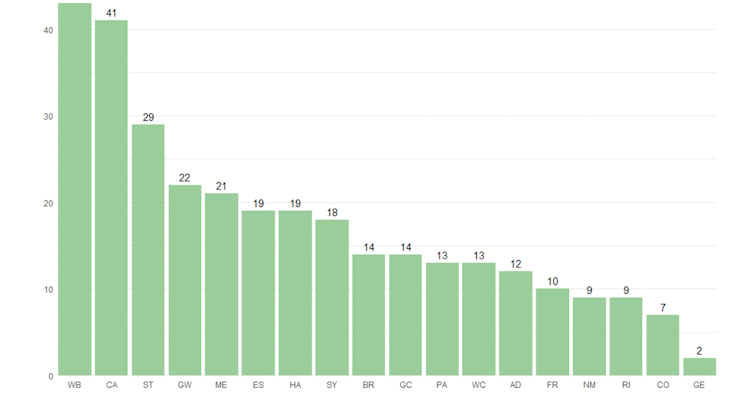What Brownlow Votes Say About Your AFL Club’s Future
Last updated: Nov 10, 2021, 1:40AM | Published: Oct 14, 2020, 2:00AM
There are many reasons why the Brownlow Medal count is consistently one of the most anticipated nights of the year.
Maybe you enjoy the red carpet fashions, maybe you enjoy Bruce McAvaney’s mid-count interviews, maybe Gillon McLachlan’s quick-fire vote-reading is music to your ears.
You can probably guess why I enjoy it: data! The Brownlow Medal votes give us some interesting information to play with, beyond just who takes home the award on the night.
In today’s piece, let’s get excited about the future. We’re going to look at the history of young Brownlow vote-getters and investigate how that leads to future success.

Does a relationship between Brownlow votes won by young players and future wins– really exist? That’s what this chart is all about.
For every year from 1990-2015, we’re looking at the number of Brownlow votes AFL clubs saw awarded to players 23 and under that year, versus how many wins their club played in four years later.
What’s clear is that this is neither a strong or simple relationship. There are points all over the place, which means that understanding as to why teams do or don’t win games requires a lot more explanation.
DOWNLOAD STATS INSIDER'S FREE 2020 BROWNLOW REPORT
But, there is something of a relationship. As the number of Brownlow votes awarded to young players goes up, so too does the odds of wins in the medium-term future.
Of course, that’s not a surprising conclusion – we would expect that promising performances from young players is generally going to lead to success.
If anything, it’s probably surprising the trend isn’t stronger. But, we’ve got keep in mind that vote totals aren’t going to perfectly reflect the quality of young players, and that plenty can go wrong in between the appearance of young talent and it reaching maturity.
In particular, the distribution of the data also makes it clear that it’s perfectly possible to be a good team in the future without having young players poll votes right now – which is good news for some of the clubs we’ll discuss shortly.
But, while the link may not be strong, it does exist. There’s some great individual examples in the data.
For example, Brisbane’s 1999 side picked up 96 Brownlow votes that year, 73 of them going to players 23 and under. It’s no surprise that they went on to do great things.
Similarly, 2004 Geelong had 92 votes to their name that year, 62 of them from players we would classify as youth. The rest, as the saying goes, is history.
So what does it mean for AFL clubs right now?

This chart shows the Brownlow votes polled by players 23 and under at last year’s count for each of the AFL’s 18 clubs.
The top six clubs in that group are the Western Bulldogs, Carlton, St Kilda, GWS, Melbourne and Essendon.
While we’ve seen that this metric offers no guarantees, it certainly suggests that each of these clubs has some promise. That's especially good news for the four of those six who missed finals this year.
At the other end of the scale are the sort of names you might expect to find there: flag contenders like Geelong, Collingwood and Richmond, whose selections are focused on winning now rather than getting games into young players.
Rounding out that bottom six are the likes of Adelaide, Fremantle and North, who were certainly not in that flag contention window last year – and perhaps it shouldn’t be a shock that all three changed coaches in that season.
Numbers like that should perhaps be a red flag for these clubs. But, as we noted previously, there are plenty of teams getting low numbers who find themselves doing just fine further down the track.
RELATED: Charting The AFL Premiership Clock: How Far Is Your Club From Its Next Flag?
Of course, 2019 numbers are by their very nature going to be a little out of date. What will the numbers look like in 2020?
That’s something we won’t know until next Monday night, but my early guess would be that the Demonsare in for another strong showing.
Last month we looked at 2020’s best young players as judged by AFLCA votes and saw that Melbourne’s23 and under brigade was a step ahead of the competition.
Christian Petracca (who only narrowly sneaks into the 23 bracket this year as he was 23 on January first) is one of the leading contenders at this year’s count.
Stats Insider’s Brownlow report has him ranked as the fourth most likely winner. That’ll be a significant boost to Melbourne’s votes as Patrick Cripps was for Carlton last year.
I’m also expecting to see both Queenslander sides do well, while we might see both Fremantle and Richmond make some significant improvements on poor 2019 tallies.
But if there’s one thing Brownlow night’s known for (other than Fevola-esque shenanigans), it’s unpredictability. We’re heading in with some clear favourites, but sometimes the count throws us a curveball.
Here’s looking forward to what should be an exciting night.
This article is provided by a guest writer. All stats and figures contained within (in this case courtesy of the fitzRoy R package) were provided by the author; and do not constitute Stats Insider data. All opinions are that of the writer.
Did you enjoy this article? Join our free mailing list to get the best content delivered straight to your inbox, or join the conversation by leaving a comment below or on the Stats Insider Twitter or Facebook page.




